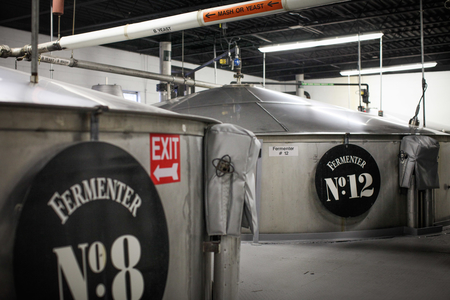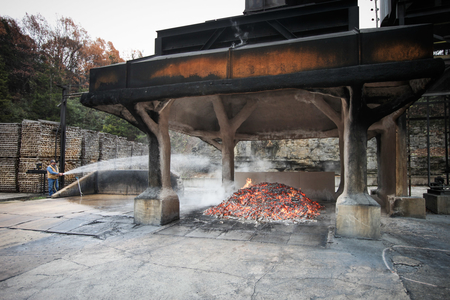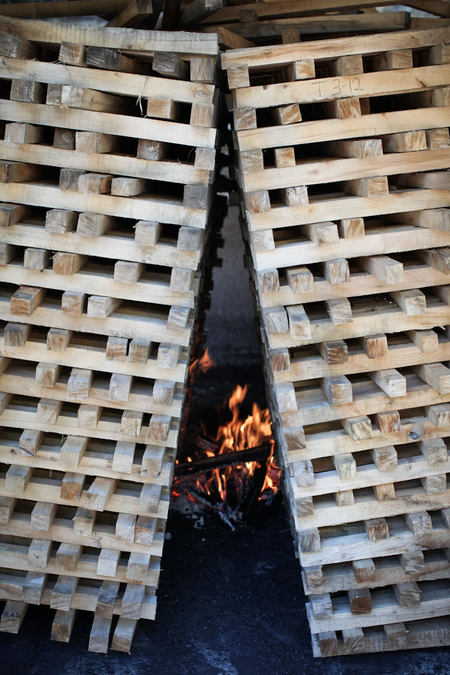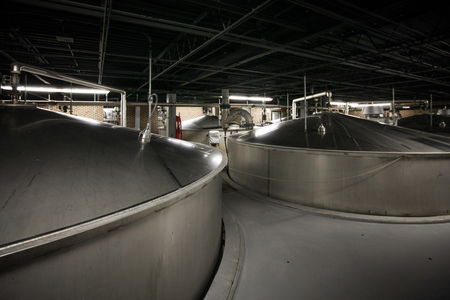
Crafting
Jack Daniel’s continues to be made to Jack’s original recipe, at the same location, using the same Lincoln County charcoal mellowing process and the same spring water. Technological advances have brought about some changes, but as a sign says on the wall of Jack’s old office, “every day we make it, we'll make it the best we can”, so you’d expect some improvements over 150 years.

Raw ingredients - Mash bill & water
Jack is made from a mash bill consisting 80% corn, 8% rye and 12% malted barley, mostly sourced from contracted farmers in America’s Midwest. The corn comes from south west Kentucky and south Illinois, the rye mostly from Western Canada and Minnesota, and the barley from Montana.
Unusually, Jack has always been made exclusively from No.1 grade corn. Over the past 150 years, production of Jack Daniel's has only stopped twice – once due to Prohibition and the other during World War II when the American government legislated that No.1 grade corn could only be used for food products. Rather than compromise quality and move to No.2 grade production was halted.
Corn is the predominant grain in the mash bill (80%) so produces a sweet spirit with light corn character. Malted barley is an essential part of the mash bill as it provides the enzyme that allows the yeast to process the rye and corn, and also provides body and a light cereal character to the whiskey. Rye is a very flavoursome spicy grain and Jack Daniel’s stands out for using a little less rye than is typical in other American whiskies. Jack Daniel’s is therefore less peppery, less spicy and a little sweeter and more oaky in character. (Incidentally, Jack specify No.1 grade plump rye.)
The grain is milled using a roller mill and mixed with water from Cave Spring Hollow, a limestone cave spring whose iron-free water runs at a constant temperature of 13°C (56°F). Iron is detrimental to the distilling process and fortuitously, limestone acts as a natural filter removing iron.

This plentiful supply of ideal distilling water is what led Jack to site his distillery here in the first place and while the flow slows slightly in summer, two million gallons a day typically flow from the cave. This is far beyond the production needs of the distillery who barely use a quarter of that, pumping around two gallons per minute to the distillery.
Municipal water is only used for cooling (which incidentally is pumped to top of hill, cooled and recycled). Even the water used to reduce the whiskey to bottling strength comes from the spring, although that is purified, using reverse osmosis.
The grain is cooked using a process lasting six days. The corn is fine milled using a hammer mill and mixed with spring water. This is heated to 100°C (212°F) and then left to cool to 77°C (170°F) at which point the rye is added and then the barley at 64°C (148°F). The three grains are cooked at different temperatures based on what is optimal just to solubilise the starches and so allow the yeast to covert this to alcohol during fermentation. The mash is then allowed to cool to 24°C (75°F) before being pumped into 40,000 gallon (151,416 litre) fermentation vats.

Fermentation & Sour Mash
While many distillers buy their yeast from third-party suppliers, usually in dried form, at Jack Daniel’s they use a proprietary yeast strain which they cultivate at the distillery’s own lab on a diet of malt and rye. This yeast is only used to make Jack Daniel’s and they can date the strain back to after prohibition when the distillery first resumed production. Back then, the yeast was stored in jars placed in water in the cave to keep it cool.
A fulltime microbiologist is charged with caring for the precious yeast which is cryogenically preserved at -80°C and also stored in two other locations just in case. In order to keep the Jack Daniel’s yeast culture pure, the distillery is ‘corrected back’ once a week with a fresh seed culture started from the original preserved culture.

Due to the term appearing prominently on the label, Jack Daniel’s is often referred to as ‘sour mash whiskey’. In fact, virtually all modern American whiskies are made using the sour mash process. In Jack Daniel’s case 2,000 gallons of sour mash are added to each fermenter. Sour mash is a proportion of the spent damp mash left in the fermenter from a previous fermentation after the liquid beer-like mash has been separated from the spent grain and sent to be distilled. Other than its use as sour mash this spent mash is a waste product which is used as animal feed.
It is known as sour mash because it introduces acidity to the new mash: so controlling the growth of bacteria that don’t like the more acidic conditions, which by contrast yeast thrive in. The sour mash also contains some of the yeast needed for fermentation, helps keep out wild yeasts and ensures a consistency between batches. In laymen’s terms this creates a bridge from batch to batch and helps maintain consistency.

The contents of each mash cooker is used to quarter fill four fermentation vats, so a proportion of four different mash cookers are used to fill each 40,000 gallon fermentation vat. It takes around 90 minutes to fill a fermenter and by the time they are filled you can already see the yeast has become very active: creating alcohol and causing the mash to immediately start bubbling. It takes 4 to 7 days for the yeast to convert the sugars into what the folk at Jack call distiller's beer (wash). During this time it goes from 19% sugar to under 2% sugar and in the process becomes 10.5% alc./vol.. It takes 5 gallons of this beer to make one gallon of whiskey.

Distillation
The distiller’s beer (wash) is distilled in continuous copper stills, four with a 1.9m (76”) diameter and two smaller ones with a 1.4m (54”) diameter. Both types are 13.7 metre (45ft) tall and they are operated in pairs with the flow from one large and one small combined. Two of the larger stills are housed in a new still hall built just over the ridge from the original. As the distillery and its aging warehouses have expanded they have run out of room in the original hollow so have been forced up the hill.

The wash enters each still at 11-12% alc./vol. about two thirds of the way up, and it passes through 19 progressive trays where steam separates the alcohol. The alcohol rises up the column while the waste liquid (stripped of any alcohol content) falls to the bottom where it is removed to be fed to local Lynchburg cattle. (Hence, they say, “the greatest steaks in the world come from here because they're marinated from the inside out.”)
At Jack Daniel’s they use all copper stills rather than cheaper, longer lasting stainless steel, as copper has the benefit of reacting sacrificially with the distiller’s beer (wash) as it boils to remove sulphur, so producing a cleaner distillate.

One of the clever quirks of these stills is the thumper (or doubler) connected to each column. The alcohol vapour leaving the top of the still is piped down to what is best described as a copper pot still. The vapour bubbles up though spirit in this still with the heat from the vapour also vaporising some of the spirit in the still as it does so. This second distillation guarantees the vapour entering the condensers is plus or minus half a percent of the target distillation point of 70% alc./vol. (140 proof). Without this, due to differences in the strength of the wash entering the column still, the distillate would vary up to 5% alc./vol. / 10 proof).
Unusually, this thumper still is powered only by the heat of the vapour from the column still. Most other American whiskey distilleries operating similar devices also use steam to boost the alcohol levels entering the condensers.
The spirit leaves the condensers at the rate of 50 to 60 gallons a minute per still and they operate constantly day and night, only being shut down for cleaning and maintenance.
Over the years the distilling technology employed at Jack Daniel’s has changed considerably. Prior to prohibition pot stills where used and columns were only introduced after prohibition. Jeff Arnett, the seventh master distiller at Jack Daniel’s says they follow Jack's guiding words, “everyday you make it, make it the best you can’. So as technologies have gotten better around distillation to make a more consistent product, we've certainly taken advantage of that and we feel that Jack would have as well.”
Charcoal mellowing
The clear distillate which emerges from the condensers after distillation is dripped at a rate of 3 litres (eight tenths of a gallon) per minute through one of 72 large white oak vats, each filled with 10 feet (3 metres) of densely packed hard sugar maple charcoal. It takes three days for the spirit to trickle through. The process, which relies purely on gravity rather than being pressurised, is known as the Lincoln County Process – so named because ‘charcoal mellowing’ was developed in the county, whose borders used to include Lynchburg.

The charcoal is made from hard sugar maples (Acer saccharum) and tall trees growing on high ground are favoured. These are split into planks about 4 foot (1.2m) long and approximately 2 inches (5cm) square, then stacked in pyres and burned to produce charcoal. Each pyre is built from 343 planks with four pyres burnt together, each pyre tilted so they collapse into each other.

The pyres are set alight using 70% alc./vol. (140˚ proof) unaged whiskey (“whiskey for destruction”) straight from the still. The wood is allowed to burn for two hours before being extinguished by dowsing with water. The resulting lumps of charcoal are ground down to a uniform size using a grinder with steel rollers and then held in stainless steel hoppers ready for use.





It takes four such burnings to make enough charcoal to fill each charcoal mellowing tank (1,700 pounds /¾ metric ton). There are two to three burnings a day and two to three days per week, depending on production needs.
A panel of tasters decide when to change the charcoal and each charcoal batch lasts up to six months. When it’s changed the charcoal is flushed through with water to wash out the impregnated whiskey which is retrieved and recycled. The spent charcoal is compressed into barbecue brackets and smoking pellets.

What’s the point of charcoal mellowing? To quote Jeff Arnett, “the reason bourbon was put into a barrel was because it has a little bit of a bitter edge when it's distilled and when people taste whiskey that has flown through charcoal mellowing, they're amazed at how that bitterness has been removed, the charcoal has a tendency to absorb that into itself. And it can accomplish in days what the barrel takes a couple of years to accomplish. So we see charcoal mellowing as giving a two year head start for Jack Daniel's, getting rid of its bitter graininess and better allowing it to take on the identity of the barrel that it's going to enter.”

Looking down into a mellowing vat. Spirit drips from holes in the bottom of pipes crisscrossing the top of the vat.
The folk at Jack say, “The charcoal mellowing process eliminates 95% of the cooked corn cereal oil notes from the distillate.” I’ve sampled mellowed and un-mellowed samples next to each other. Before mellowing the spirit has cooked sweetcorn, almost beer-like notes with faint overripe banana. It is slightly bitter with an oily mouthfeel. After mellowing, the spirit is much lighter with pear and apple fruitiness, a cleaner character and a much shorter finish.

One of three rooms filled with mellowing vats.
Aging
The charcoal mellowed spirit is aged in new charred white oak barrels for over four years (around 52 months). The casks are stored in 89 ageing warehouses covering 2,000 acres atop the hills overlooking Lynchburg – all in Moore County. Greater changes in temperature occur higher up so maturation proceeds slightly faster. The smallest warehouses hold 6,000 barrels while the newer lager warehouses each hold 54,000 barrels giving a total aging inventory of some 2.5 million barrels of ageing whiskey.

Once placed in a rick on a particular the floor of a warehouse each barrel is left undisturbed until its contents are judged ready to bottle. Jack Daniel’s do not move barrels across floors within their warehouses, nor do they heat, cool or control moisture levels. Temperature and moisture are left to Mother Nature herself to control.

Most of the warehouses, which are of wood construction and painted grey, are seven stories high but the newer buildings are eight stories high. Whiskey to be bottled as Jack Daniel’s Single Barrel only comes from casks stored on the top seventh and eighth floors.
The lower floors are typically more humid and cooler. The higher a barrel is racked in the warehouse the more heat it will be exposed to, and due to expansion the woods pores will open allowing the whiskey to penetrate deeper into the wood, so taking on more of the barrel’s character. Hence bottling from batches of barrels selected from a mix of floors is essential to maintain Old No. 7’s consistent flavour profile.

Some 5,000 barrels a year are selected from the top floors to be Jack Daniel’s Single Barrel, each yielding around 240 bottles of whiskey. Whilst the barrels on the lower floors destined to become Old No.7 lose around 10% ‘angel’s share’ evaporation, the Single Barrel casks on the hot top floor lose as much as 30% to angel’s share.
The white oak used to make the barrels comes from the eastern half of the US: Arkansas, Missouri and the Carolinas. Brown-Forman have their own sawmill in each location, but can buy more oak if required. White oak takes 30-50 years to grow and Brown-Forman owns a 30-acre site used to grow hard sugar maple and American white oak saplings for its replanting program.
Brown-Forman also operate their own cooperage and are the only American whiskey company to make their own barrels. They employ almost as many to make the barrels as they do to make the whiskey. Part of their proprietary process is a two-stage charring process. When each barrel is formed, before the heads are put in place, heat is slowly introduced to soften the wood sugars and caramelise them. This gentle toasting is then followed with charring.
Charring helps colour the whiskey, but more importantly it opens the oak which allows the aging whiskey to better penetrate and take flavours from the wood. Toasting brings out natural sugars and vanillins in the wood whilst charring releases dry tannins. So, as Jeff Arnett says, “toasting and then charring gives two ends of the pallet; sweet on the tip of the tongue and oak on the back when you swallow.”
Each barrel can only be used once and the spent casks are sold to other distillers around the world to age products such as rum and Scotch whisky. You can spot a Jack Daniel's barrel by its rivets as these carry the letter ‘B’, indicating it was made at the Brown-Forman Cooperage (previously named the Blue Grass Cooperage).

Bottling
When the whiskey reaches maturity, the contents of 200 barrels are combined and reduced to bottling strength using demineralised cave spring water. Each batch is bottled separately; there is no blending of batches or solera vatting at the bottling hall.
All of Jack Daniel’s whiskies are made and bottled in Lynchburg. Jack Daniel’s is not bulk shipped, but instead bottled near to where it is distilled and then shipped in the bottle.
Click on the arrow on the right of the image below to scroll through more production photographs.


















Jack Daniel's
Established: 1866
Owner: Brown-Forman Corporation
Capacity: Not supplied
Visitor Policy: Visitors welcome throughout the year
Tel: +1 931 759 6357
Website: Jack Daniel's
Address: 182 Lynchburg Highway, Lynchburg, Tennessee, 37352

Jack Daniel's Rye
Introduced in 2017, this Tennessee rye whiskey is made with the first new Jack Daniel's mashbill since 1866 comprising: 70% rye, 18% corn and 12% malted

Jack Daniel's Single Barrel Rye
Introduced 2016, this is the Single Barrel Collection edition of Jack Daniel's Tennessee Rye whiskey, made using the first new Jack Daniel's mashbill since

Jack Daniel's Old No.7 Brand
Jack Daniel's is a Tennessee whiskey and was named No.7 by Mr Jack himself in 1887 – no one knows why.

Jack Daniel's Tennessee Honey
Launched in 2010 and made by blending Jack Daniel's Old No. 7 with honey liqueur developed in Brown-Forman's Louisville plant to have a nutty flavour reminiscent

Gentleman Jack
As with Old No. 7, the distillate used to make Gentleman Jack is slow-dripped through 10 feet (3m) of densely packed hard sugar maple charcoal over 3 days

Jack Daniel's Green Label
Popular belief has it that Jack Daniel’s was originally sold with a green label at a lower age, the black label only launched after Jack’s death in

Jack Daniel's Single Barrel
Jack Daniel's Single Barrel is made by the same process as Jack Daniel's Old No.7 but tends to be aged for 5½ to 6 years (certainly never less than 5

Jack Daniel's Maxwell House Commemorative Bottle
The Maxwell House bottling is one in a range of commemorative bottles containing the same whiskey as the standard No.7 Black Label, although the alcoholic

Jack Daniel's Silver Select
This line Jack extension was developed for the travel-retail (duty-free) market. Silver Select is basically Jack Daniel’s Single barrel but with better

Jack Daniel's Monogram
Released early in 2007 as a travel retail (duty free) exclusive, Monogram is now longer made so has become something of a collector’s piece. Comparable

Jack Daniel's Old No.7 Cola
This black and white can with familiar Jack Daniel’s branding and red highlights proclaims its contents to be “A perfect mix of whiskey & cola”.

Jack Daniel's White Rabbit Saloon
This 2012 limited edition Jack Daniels bottling celebrates the 120 anniversary of the opening of the White Rabbit Saloon in 1892. One of two bars “Mr

Jack Daniel's Sinatra Select
Launched December 2012, this special edition Jack Daniel's whiskey honours Frank Sinatra, a devoted fan of the Tennessee Whiskey. It is matured in Sinatra

Tennessee Fire
Launched in the U.S. April 2014, “Jack Fire” is made with Jack Daniel’s Old No. 7 whiskey with a proprietary red hot cinnamon liqueur.

Jack Daniel's Unaged Tennessee Rye
Released late in 2012, this “white whiskey” is the first time since before Prohibition that the Jack Daniel Distillery has used a new grain recipe.





